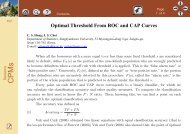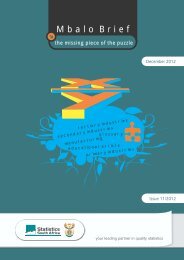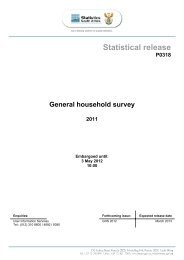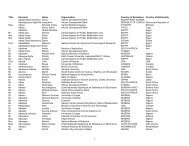Post-enumeration Survey (PES) - Statistics South Africa
Post-enumeration Survey (PES) - Statistics South Africa
Post-enumeration Survey (PES) - Statistics South Africa
Create successful ePaper yourself
Turn your PDF publications into a flip-book with our unique Google optimized e-Paper software.
<strong>Statistics</strong> <strong>South</strong> <strong>Africa</strong><br />
61<br />
8. CONTENT EVALUATION – PERSONS ONLY<br />
8.1 Nature of content analysis<br />
Content error, also known as response error, is defined as the deviation of the obtained value from the<br />
true value for a given characteristic. Depending on whether essential or transient conditions are involved,<br />
response error can be divided into response bias (systematic error) and response variance (variable<br />
error). The <strong>PES</strong> is regarded as a replication, an independent re-interview of a sample from the census<br />
for the purpose of estimating variable error, not bias. The <strong>PES</strong> content error analysis measures<br />
consistency, not which answers are right or wrong, i.e. it measures how differently answers are<br />
reported between the census and the <strong>PES</strong>.<br />
The following characteristics were selected for content error analysis:<br />
• Sex<br />
• Age group<br />
• Relationship to head of household<br />
• Marital status<br />
• Population group<br />
To ensure comparability between the <strong>PES</strong> and the census, the same wording, response categories and<br />
precodes, and also the same concept definitions, were maintained in the <strong>PES</strong>. First, estimated totals<br />
from the census and the <strong>PES</strong>, as reported in the census and as reported in the <strong>PES</strong>, are compared for<br />
matched persons for the selected characteristics. The number of cases in agreement in the universe is<br />
observable along the diagonal.<br />
Variability between the census and the <strong>PES</strong> is then measured by means of four different indicators: the<br />
net difference rate, the index of inconsistency (simple and aggregate), the gross difference rate, and the<br />
rate of agreement. These measures and their confidence intervals are presented for the selected<br />
characteristics.<br />
• Net Difference Rate (NDR). The net difference rate is the difference between the number of cases in<br />
the census and the number of cases in the <strong>PES</strong> that fall under each response category, relative to<br />
the total number of matched persons in all response categories.<br />
• Index of Inconsistency. The index of inconsistency is the relative number of cases for which the<br />
response varied between the census and the <strong>PES</strong>. It is the ratio of the simple response variance to<br />
the total variance of the characteristic, including its variability in the population. It is calculated for<br />
each response category.<br />
<strong>Post</strong> Enumeration <strong>Survey</strong> (<strong>PES</strong>)















